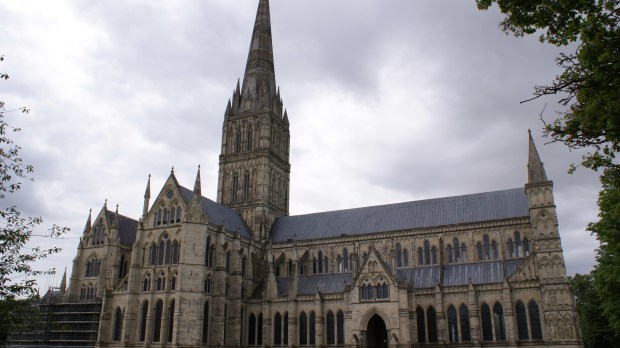Lenten Campaign 2025
This content is free of charge, as are all our articles.
Support us with a donation that is tax-deductible and enable us to continue to reach millions of readers.
The sacred and the profane are both on display at the Cathedral Church of the Blessed Virgin Mary in Salisbury, in the South of England. An exhibit there, delayed because of the COVID-19 pandemic, tells the story of how the cathedral came to settle where it is eight centuries ago and offers insight into the lives of medieval worshipers.
Prominent in the exhibit celebrating the 800th anniversary of the laying of the new foundation is a papal bull permitting the cathedral to be rebuilt, after its first location proved to be problematic.
First constructed in the late 11th century at Old Sarum, on the outskirts of modern Salisbury, the cathedral turned out to be afflicted by local weather conditions and bad neighbors.
“Disgruntled clergy in Salisbury complained their services were being drowned out by the blustery conditions,” according to a report in the Guardian.
Not only that, but the roof was constantly leaky, and the damp climate inside the building seemed to be making everyone sick.
To top it all off, “bullying soldiers” at nearby Old Sarum Castle persistently kept the faithful from visiting the temple “on security grounds.”
Fed up, local clergy finally reached out to Pope Honorius III. Remember, this is long before Henry VIII broke off relations with Rome, so the Church in England still had recourse to remedy from the See of Peter.
“The cathedral is subject to so much inconvenience and oppression, that you cannot live there without great danger to life and limb,” Honorius wrote (in Latin) in his bull of March 29, 1218. “For as it is situated on a considerable eminence it is continually buffeted by the winds, so that you can scarcely hear each other speak while you are celebrating the divine offices and the place is so damp that those who live there are subject to constant illnesses.”
The pontiff recognized that the local population was “scarcely sufficient” to provide for repairs to the roof of the church, “which are constantly damaged by storms.” He also said that they were obliged to buy water at “as great a price as would elsewhere be sufficient to buy the common drink of the country, nor can they have access to it without the permission of the castle guard.”
Enough reason to pull up stakes. The new church was finished in 1258, with a spire added in the early 1300s. It is currently the tallest church spire in England.
While the bull — part of a collection that contains the original cathedral’s charter and a description of the laying of the new foundations stones — is as official as a document you can get, another parchment gives some insight into life in medieval times. As the Guardian paints the picture:
Another spectacular exhibit is a six-meter-long scroll detailing the annual food consumption of the cathedral’s canon treasurer and household in the 13th century. He and his staff, it turns out, were fond of beef, mutton and pork. Friday was fish day, with a selection of herring, plaice and ling on offer, while for special feasts he tucked into spiced sauces, pies and pasties flour for fritters.
“These documents give us an insight into the life of our medieval ancestors who worked and worshipped here, forming a unique link between the past and the present,” said Emily Naish, the Salisbury Cathedral archivist. “The cathedral’s 800th anniversary is a marvellous opportunity for us to display some of the greatest treasures from our collections.”

